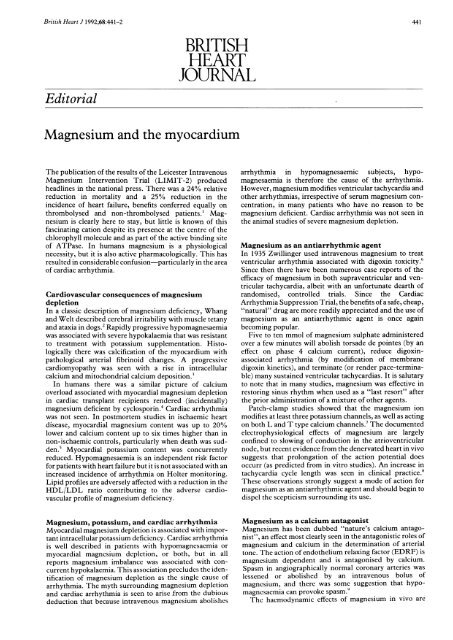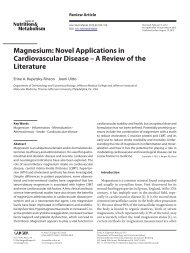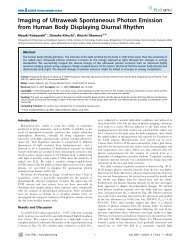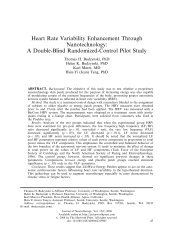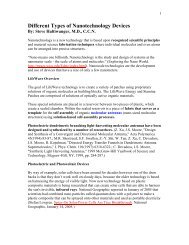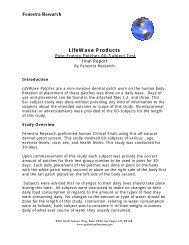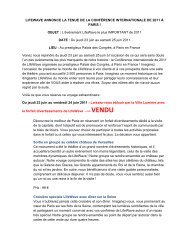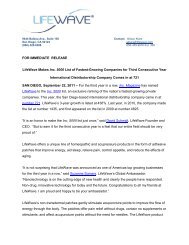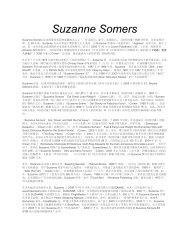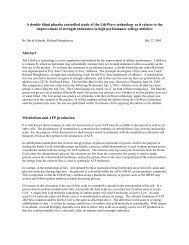Millane T A, Camm A J. Magnesium and the Myocardium ... - LifeWave
Millane T A, Camm A J. Magnesium and the Myocardium ... - LifeWave
Millane T A, Camm A J. Magnesium and the Myocardium ... - LifeWave
Create successful ePaper yourself
Turn your PDF publications into a flip-book with our unique Google optimized e-Paper software.
British Heart J 1992;68:441-2441EditorialBRITISHHEARTJOUJRNAL<strong>Magnesium</strong> <strong>and</strong> <strong>the</strong> myocardiumThe publication of <strong>the</strong> results of <strong>the</strong> Leicester Intravenous<strong>Magnesium</strong> Intervention Trial (LIMIT-2) producedheadlines in <strong>the</strong> national press. There was a 24% relativereduction in mortality <strong>and</strong> a 25% reduction in <strong>the</strong>incidence of heart failure, benefits conferred equally onthrombolysed <strong>and</strong> non-thrombolysed patients.' <strong>Magnesium</strong>is clearly here to stay, but little is known of thisfascinating cation despite its presence at <strong>the</strong> centre of <strong>the</strong>chlorophyll molecule <strong>and</strong> as part of <strong>the</strong> active binding siteof ATPase. In humans magnesium is a physiologicalnecessity, but it is also active pharmacologically. This hasresulted in considerable confusion-particularly in <strong>the</strong> areaof cardiac arrhythmia.Cardiovascular consequences of magnesiumdepletionIn a classic description of magnesium deficiency, Whang<strong>and</strong> Welt described cerebral irritability with muscle tetany<strong>and</strong> ataxia in dogs.2 Rapidly progressive hypomagnesaemiawas associated with severe hypokalaemia that was resistantto treatment with potassium supplementation. Histologically<strong>the</strong>re was calcification of <strong>the</strong> myocardium withpathological arterial fibrinoid changes. A progressivecardiomyopathy was seen with a rise in intracellularcalcium <strong>and</strong> mitochondrial calcium deposition.3In humans <strong>the</strong>re was a similar picture of calciumoverload associated with myocardial magnesium depletionin cardiac transplant recipients rendered (incidentally)magnesium deficient by cyclosporin.4 Cardiac arrhythmiawas not seen. In postmortem studies in ischaemic heartdisease, myocardial magnesium content was up to 20%lower <strong>and</strong> calcium content up to six times higher than innon-ischaemic controls, particularly when death was sudden.5Myocardial potassium content was concurrentlyreduced. Hypomagnesaemia is an independent risk factorfor patients with heart failure but it is not associated with anincreased incidence of arrhythmia on Holter monitoring.Lipid profiles are adversely affected with a reduction in <strong>the</strong>HDL/LDL ratio contributing to <strong>the</strong> adverse cardiovascularprofile of magnesium deficiency.<strong>Magnesium</strong>, potassium, <strong>and</strong> cardiac arrhythmiaMyocardial magnesium depletion is associated with importantintracellular potassium deficiency. Cardiac arrhythmiais well described in patients with hypomagnesaemia ormyocardial magnesium depletion, or both, but in allreports magnesium imbalance was associated with concurrenthypokalaemia. This association precludes <strong>the</strong> identificationof magnesium depletion as <strong>the</strong> single cause ofarrhythmia. The myth surrounding magnesium depletion<strong>and</strong> cardiac arrhythmia is seen to arise from <strong>the</strong> dubiousdeduction that because intravenous magnesium abolishesarrhythmia in hypomagnesaemic subjects, hypomagnesaemiais <strong>the</strong>refore <strong>the</strong> cause of <strong>the</strong> arrhythmia.However, magnesium modifies ventricular tachycardia <strong>and</strong>o<strong>the</strong>r arrhythmias, irrespective of serum magnesium concentration,in many patients who have no reason to bemagnesium deficient. Cardiac arrhythmia was not seen in<strong>the</strong> animal studies of severe magnesium depletion.<strong>Magnesium</strong> as an antiarrhythmic agentIn 1935 Zwillinger used intravenous magnesium to treatventricular arrhythmia associated with digoxin toxicity.6Since <strong>the</strong>n <strong>the</strong>re have been numerous case reports of <strong>the</strong>efficacy of magnesium in both supraventricular <strong>and</strong> ventriculartachycardia, albeit with an unfortunate dearth ofr<strong>and</strong>omised, controlled trials. Since <strong>the</strong> CardiacArrhythmia Suppression Trial, <strong>the</strong> benefits of a safe, cheap,"natural" drug are more readily appreciated <strong>and</strong> <strong>the</strong> use ofmagnesium as an antiarrhythmic agent is once againbecoming popular.Five to ten mmol of magnesium sulphate administeredover a few minutes will abolish torsade de pointes (by aneffect on phase 4 calcium current), reduce digoxinassociatedarrhythmia (by modification of membranedigoxin kinetics), <strong>and</strong> terminate (or render pace-terminable)many sustained ventricular tachycardias. It is salutaryto note that in many studies, magnesium was effective inrestoring sinus rhythm when used as a "last resort" after<strong>the</strong> prior administration of a mixture of o<strong>the</strong>r agents.Patch-clamp studies showed that <strong>the</strong> magnesium ionmodifies at least three potassium channels, as well as actingon both L <strong>and</strong> T type calcium channels.7 The documentedelectrophysiological effects of magnesium are largelyconfined to slowing of conduction in <strong>the</strong> atrioventricularnode, but recent evidence from <strong>the</strong> denervated heart in vivosuggests that prolongation of <strong>the</strong> action potential doesoccurr (as predicted from in vitro studies). An increase intachycardia cycle length was seen in clinical practice.8These observations strongly suggest a mode of action formagnesium as an antiarrhythmic agent <strong>and</strong> should begin todispel <strong>the</strong> scepticism surrounding its use.<strong>Magnesium</strong> as a calcium antagonist<strong>Magnesium</strong> has been dubbed "nature's calcium antagonist",an effect most clearly seen in <strong>the</strong> antagonistic roles ofmagnesium <strong>and</strong> calcium in <strong>the</strong> determination of arterialtone. The action of endo<strong>the</strong>lium relaxing factor (EDRF) ismagnesium dependent <strong>and</strong> is antagonised by calcium.Spasm in angiographically normal coronary arteries waslessened or abolished by an intravenous bolus ofmagnesium, <strong>and</strong> <strong>the</strong>re was some suggestion that hypomagnesaemiacan provoke spasm.'The haemodynamic effects of magnesium in vivo are
442largely mediated by a fall in systemic vascular resistancesecondary to arteriolar vasodilatation. An intravenousbolus sufficient to double serum concentrations is clearedfrom <strong>the</strong> blood within 20 minutes, largely by renal excretion.Optimistic trials exploiting <strong>the</strong>se effects to treatsystemic hypertension with oral magnesium have met withlittle success-rapid clearance by <strong>the</strong> kidney preventsserum concentrations rising above normal.'"The use of intravenous magnesium in <strong>the</strong> acute treatmentof uncontrolled pregnancy related hypertension (preeclampsia)is established in Australia <strong>and</strong> <strong>the</strong> UnitedStates, but for some reason has not proved popular inEurope. The intense vasoconstriction associated with thiscondition is particularly sensitive to <strong>the</strong> dilatatory effects ofmagnesium, which also acts in neurological tissue as amembrane stabiliser to reduce muscular <strong>and</strong> cerebralirritability. Indeed, <strong>the</strong> first use of magnesium in humansrelated to an attempt to induce "anaes<strong>the</strong>sia" in twointrepid researchers, who discovered that <strong>the</strong> illusion ofanaes<strong>the</strong>sia was in fact a state of profound muscle relaxationbounding on-paralysis!"<strong>Magnesium</strong> as an anti-ischaemic agentMeta-analysis of several trials has suggested a beneficial rolefor intravenous magnesium infused in <strong>the</strong> 24 hours afteracute myocardial infarction. 2 The most recent of<strong>the</strong> International Studies of Infarct Survival (ISIS 4),investigating <strong>the</strong> effects of oral nitrates <strong>and</strong> angiotensinconverting enzyme inhibitors includes a similar period ofintravenous magnesium administration in a 2 x 2 x 2 factorialdesign, <strong>and</strong> will complement <strong>the</strong> results of <strong>the</strong>LIMIT-2 study.The mechanisms of action of magnesium in thiscircumstance are unknown. A significant reduction in <strong>the</strong>incidence of cardiogenic shock was noted in one study,which, taken with <strong>the</strong> LIMIT-2 data, suggests that magnesiummay preserve left ventricular function by reducingischaemic damage. Evidence from animal models suggeststhat this may be due to reduction in calcium-mediatedischaemic damage. During ischaemia, intracellular freemagnesium concentrations rise rapidly as <strong>the</strong> formation ofATP from ADP (incorporating magnesium) is limited byhypoxia <strong>and</strong> acidosis with subsequent loss of magnesiumfrom <strong>the</strong> cell magnified by cAMP mediated 13 receptorstimulation.'3 During reperfusion, magnesium is re-incorporatedinto ATP to produce a net fall in intracellular freemagnesium with reciprocal calcium overload.In addition to any possible antiarrhythmic action, magnesiumraises fibrillation thresholds; it also has antiplatelet<strong>Millane</strong>, Cainiiieffects mediated via prostacyclin, prolonging bleedingtime. '" The beneficial effects of magnesium on arterial tonemay also be important in what will prove to be a verycomplex relation.<strong>Magnesium</strong> deficiency is probably an important riskfactor in cardiovascular disease that has adverse effects onarterial tone <strong>and</strong> myocardial calcium balance. The arrhythmogeniceffects of hypomagnesaemia are not seen in <strong>the</strong>absence of concomitant potassium imbalance. Therapeutically,magnesium has many of <strong>the</strong> characteristics of<strong>the</strong> ideal drug-it is simple, cheap, has a wide <strong>the</strong>rapeuticrange, a short half-life <strong>and</strong> a limited capacity for adverseinteraction with o<strong>the</strong>r agents. As an adjuvant antiarrhythmicagent for <strong>the</strong> acute control of ventriculartachycardia, magnesium might be considered as a first lineagent. Its potential anti-ischaemic actions are becomingestablished in myocardial infarction, but it might alsoprove useful in unstable angina <strong>and</strong> in <strong>the</strong> peri <strong>and</strong> postangioplasty periods.Department of Cardiological Sciences,St George's Hospital Medical School,LondonT A MILLANEA J CAMM1 Woods K, Fletcher S, Roffe C, Haider Y. Intravenous magnesium sulphate insuspected myocardial infarction: results of <strong>the</strong> second Leicester Intravenous<strong>Magnesium</strong> Intervention Trial (LIMIT-2). Lancet 1992;339:1553-8.2 Whang R, Welt L. Observations in experimental magnesium depletion.J Clin Invest 1963;42:305-13.3 Heggtveit H. The cardiomyopathy of magnesium-deficiency. In: Bajusz E,ed. Electrolytes <strong>and</strong> cardiovascular diseases. Basel/New York: S Karger,1965:204-20.4 <strong>Millane</strong> T, Jennison S, Patel M, Moss R, Holt D, McKenna W. Progressivemyocardial calcification associated with prolonged hypomagnesemia aftercardiac transplantation [abstri. J Am Coll Cardiol 1992;19:396.5 Johnson CJ, Peterson DR, Smith EK. Myocardial tissue concentrations ofmagnesium <strong>and</strong> potassium in men dying suddenly from ischaemic heartdisease. Am J Clin Nutr 1979;32:967-70.6 Zwillinger L. Uber die <strong>Magnesium</strong>wirkung auf das Herz. Klin Wochnenschr1 935;14: 1429-33.7 Agus Z, Morad M. Modulations of cardiac ion channels by magnesium.Annu Rev Physiol 1991;53:299-307.8 DiCarlo LA, Morady F, de Buitleir M, Krol RB, Schurig L, Annesley TM.Effects of magnesium sulfate on cardiac conduction <strong>and</strong> refractoriness inhumans. J Am Coll Cardiol 1986;7:1356-62.9 Miyagi H, Yasue H, Okumura K, Ogawa H, Goto K, Oshima S. Effect ofmagnesium on an anginal attack induced by hyperventilation in patientswith variant angina. Circulation 1989;79:597-602.10 Cappuccio FP, Mark<strong>and</strong>u ND, Beynon GW, Shore AC, Sampson B,MacGregor GA. Lack of effect of oral magnesium on high blood pressure: adouble blind study. Br Med J 1985;291:235-8.11 Neuwirth I, Wallace G. On <strong>the</strong> use of magnesium as an aid to anaes<strong>the</strong>sia.J Pharmacol Exp Ther 1929;35:171-87.12 Teo K, Yusuf S, Collins R, Held P, Peto R. Effects of intravenous magnesiumin suspected myocardial infarction: overview of r<strong>and</strong>omised trials. B MedJ 1991;303:1499-504.13 Romani A, Scarpa A. Hormonal control ofMg transport in <strong>the</strong> heart. Nature1990;346:841-4.14 Lauler DP, Seelig M, Hollifield JW, et al. A symposium: <strong>Magnesium</strong>deficiency-pathogenesis, prevalence, <strong>and</strong> strategies for repletion. An? JCardiol 1989;63:1-46.


